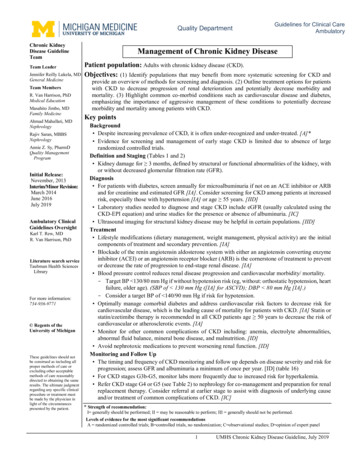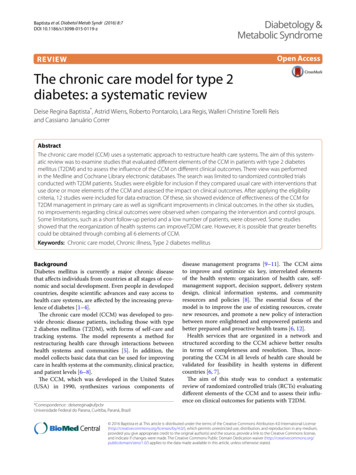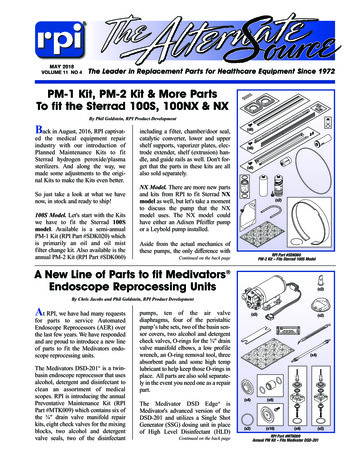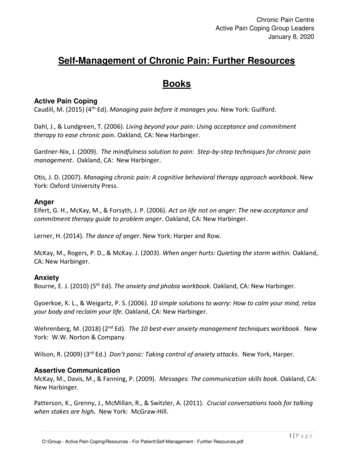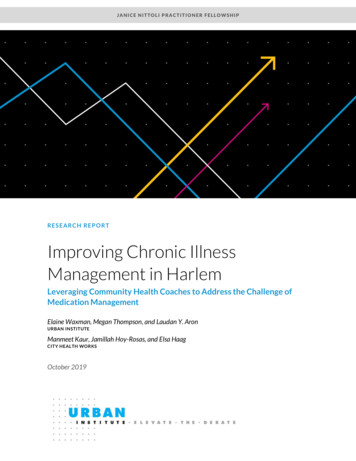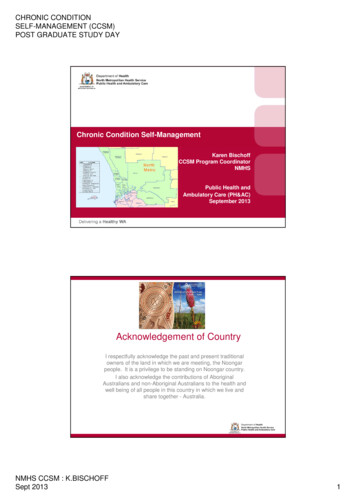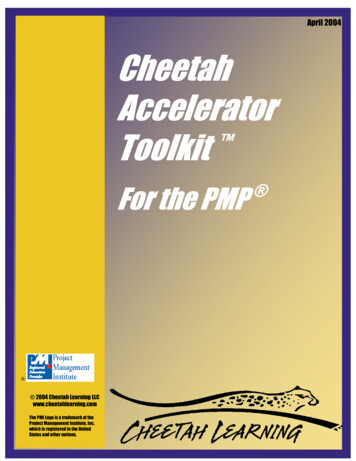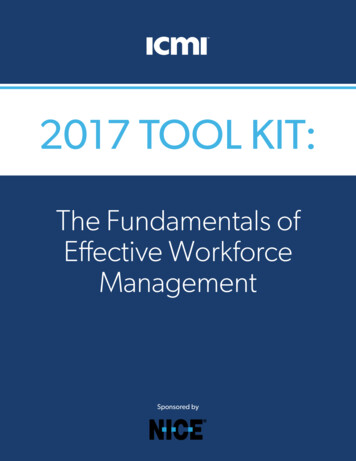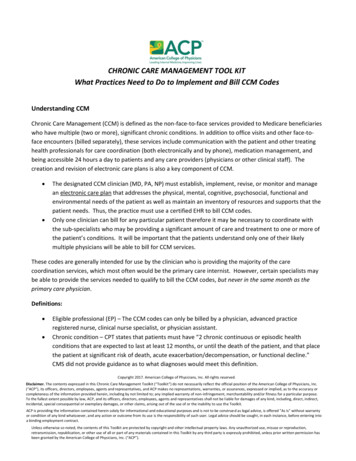
Transcription
CHRONIC CARE MANAGEMENT TOOL KITWhat Practices Need to Do to Implement and Bill CCM CodesUnderstanding CCMChronic Care Management (CCM) is defined as the non-face-to-face services provided to Medicare beneficiarieswho have multiple (two or more), significant chronic conditions. In addition to office visits and other face-toface encounters (billed separately), these services include communication with the patient and other treatinghealth professionals for care coordination (both electronically and by phone), medication management, andbeing accessible 24 hours a day to patients and any care providers (physicians or other clinical staff). Thecreation and revision of electronic care plans is also a key component of CCM. The designated CCM clinician (MD, PA, NP) must establish, implement, revise, or monitor and managean electronic care plan that addresses the physical, mental, cognitive, psychosocial, functional andenvironmental needs of the patient as well as maintain an inventory of resources and supports that thepatient needs. Thus, the practice must use a certified EHR to bill CCM codes.Only one clinician can bill for any particular patient therefore it may be necessary to coordinate withthe sub-specialists who may be providing a significant amount of care and treatment to one or more ofthe patient’s conditions. It will be important that the patients understand only one of their likelymultiple physicians will be able to bill for CCM services.These codes are generally intended for use by the clinician who is providing the majority of the carecoordination services, which most often would be the primary care internist. However, certain specialists maybe able to provide the services needed to qualify to bill the CCM codes, but never in the same month as theprimary care physician.Definitions: Eligible professional (EP) – The CCM codes can only be billed by a physician, advanced practiceregistered nurse, clinical nurse specialist, or physician assistant.Chronic condition – CPT states that patients must have “2 chronic continuous or episodic healthconditions that are expected to last at least 12 months, or until the death of the patient, and that placethe patient at significant risk of death, acute exacerbation/decompensation, or functional decline.”CMS did not provide guidance as to what diagnoses would meet this definition.Copyright 2017. American College of Physicians, Inc. All rights reserved.Disclaimer. The contents expressed in this Chronic Care Management Toolkit (“Toolkit”) do not necessarily reflect the official position of the American College of Physicians, Inc.(“ACP”), its officers, directors, employees, agents and representatives, and ACP makes no representations, warranties, or assurances, expressed or implied, as to the accuracy orcompleteness of the information provided herein, including by not limited to; any implied warranty of non-infringement, merchantability and/or fitness for a particular purpose.To the fullest extent possible by law, ACP, and its officers, directors, employees, agents and representatives shall not be liable for damages of any kind, including, direct, indirect,incidental, special consequential or exemplary damages, or other claims, arising out of the use of or the inability to use the Toolkit.ACP is providing the information contained herein solely for informational and educational purposes and is not to be construed as legal advice, is offered "As Is" without warrantyor condition of any kind whatsoever, and any action or outcome from its use is the responsibility of such user. Legal advice should be sought, in each instance, before entering intoa binding employment contract.Unless otherwise so noted, the contents of this Toolkit are protected by copyright and other intellectual property laws. Any unauthorized use, misuse or reproduction,retransmission, republication, or other use of all or part of any materials contained in this Toolkit by any third party is expressly prohibited, unless prior written permission hasbeen granted by the American College of Physicians, Inc. (“ACP”).
Comprehensive Care Plan – This is an electronic summary of the physical, mental, cognitive,psychosocial, functional, and environmental assessments, a record of all recommended preventive careservices, medication reconciliation with review of adherence and potential interactions and oversightof patient self-management of medications, an inventory of clinicians, resources, and supports specificto the patients, including how the services of agencies or specialists unconnected to the designatedphysician’s practice will be coordinated. Including assurance of care appropriate for patient’s choicesand values.Clinical staff – Licensed clinical staff members (including APRN, PA, RN, LSCSW, LPN, clinicalpharmacists, and “medical technical assistants” or CMAs) who are directly employed by the clinician (orthe clinician’s practice) or a contracted third party and whose CCM services are generally supervised bythe clinician, whether provided during or after hours. Thus the “incident to” rules do not necessarilyrequire that the clinician be on the premises providing direct supervision.Contact-based care – To count the time towards the 20-minutes of non-face-to-face time, the caremust be “contact initiated.” This could be patient-doctor, patient-nurse, doctor-doctor, pharmacydoctor, lab-doctor, or other contact regarding or by the patient via phone or electronic communication.General planning time or care coordination doesn’t count unless it is initiated based on a contactand/or results in a patient or patient-related contact. For example, if the pharmacist calls the officebecause the patient reported a rash, then the time counts. If the office spends time running a report ofall participants due for a flu shot or an A1C check, that time doesn’t count. When they call and speakto the patient and then coordinate care, then that time would count. In-person visits, including groupvisits, do not count toward CCM codes.Certified CCM technology – CCM codes must be provided by a certified EHR.Codes: CPT code 99490 – CCM services, at least 20 minutes per month. The 2018 average reimbursement is 42.84 adjusted based on geography.CPT code 99487 – Complex CCM services, 60 minutes of clinical staff time per month. Average 2018reimbursement is 94.68.CPT code 99489 – Complex CCM services, each additional 30 minutes of clinical staff time per month.Average 2018 reimbursement is 47.16.HCPCS code G0506 – Care Planning for Chronic Care Management. 2018 reimbursement is 64.44.CPT code 99091 – Collection and interpretation of physiologic data (e.g., ECG, blood pressure, glucosemonitoring) digitally stored and/or transmitted by the patient and/or caregiver to the physician orother qualified health care professional, qualified by education, training, licensure/regulation (whenapplicable) requiring a minimum of 30 minutes of time (for 2018 pending anticipated changes in CPTcoding). 2018 average reimbursement is 58.68.Billing: The practice must have the patient’s written or oral consent in order to bill for CCM services (seeAttachment 2).2Copyright 2017. American College of Physicians, Inc. All rights reserved.
Only one clinician can furnish and be paid for CCM services during a calendar month. The clinician whois providing the primary care to the patient is the one who can bill. Usually this will be the primary careinternist, but some specialists may be serving as the patient’s primary care physician.Copayments (coinsurance and deductibles) DO apply, unless performed at the same time as the AnnualWellness Visit.The following codes cannot be billed during the same month as CCM (CPT 99490):o Transition Care Management (TCM) – CPT 99495 and 99496o Home Healthcare Supervision – HCPCS G0181o Hospice Care Supervision – HCPCS G9182o Certain ESRD services – CPT 90951-90970If other E&M or procedural services are provided, those services will be billed as appropriate. Thattime can NOT be counted toward the 20 minutes. If time, such as from a phone call, leads to an officevisit resulting in an E&M charge, that time would be included in the billed office visit, NOT the CCMtime.Documentation: Document patient consent, if they declined to participate, or indicated participation elsewhere (and ifso, with whom). Oral consent is acceptable until the next time the patient comes to the office, whenthey should sign the written consent (but it is not required).Document 20 minutes of non-face-to-face clinical staff time. Each practice will need to develop its ownconsistent system of documentation based on its unique physical, staffing, and EHR configuration.Consideration should include documentation of care provided by both internal and external (such asfor call coverage) individuals, who and how care will be documented in the record, and how todocument time spent doing different aspects of care and care coordination. It is quite possible thatthere will not be a CCM code billed for every patient every month, some months may not generate 20minutes of care coordination.If after hours care is provided by a clinician who is not part of the practice, such as for call coverage,that individual must have access to the electronic care plan (other than by facsimile). The care planmay be accessed via a secure portal, a hospital platform, a web-based care management application, ahealth information exchange, or an EHR to EHR interface.Services can be provided “incident-to” the designated clinician if the CCM services are provided bylicensed clinical staff employed by the clinician or practice who are under the general, not necessarilythe direct, supervision of the designated clinician. The normal “incident-to” documentationrequirements apply.Contracted clinicians, such as covering clinicians or locum tenens, count as long as they provide theinformation in a timely manner, which can be done by electronic means including fax.3Copyright 2017. American College of Physicians, Inc. All rights reserved.
How to Implement CCM CodesStep 1: Identify the patients Use your EHR to search for patients that have 2 or more chronic conditions. Run reports sorted byphysician. Each physician can then review his/her report and cross off anyone he/she does not think isa good fit for the CCM program.The patient must have 2 or more chronic conditions that have the following required elements:o Multiple (2 or more) chronic conditions that are expected to last at least 12 months or untildeath; ando Place the patient at significant risk of death, acute exacerbation/decompensation, or functionaldecline.Initially, you may wish to focus on a small number of specific diagnoses, such as diabetes, COPD, CVD,and/or A-fib. Create a log of participating CCM patients [Attachment 1]Step 2: Designate a personnel for each identified patient – primary clinician, nurse, and other staff helping withenrollment, consents, and scheduling. Patient should be able to access “successive routine appointments” with the designated clinician.Other licensed clinical staff can provide services “incident to” the primary clinician, as long as theprimary provide is providing general supervision.Step 3: Design a CCM process and schedule. Set up appointment codes for new visits and nurse assessment calls as needed.As enrollment increases, consider designating time frames for clinician visits and nurse calls (new andsubsequent).Assign CCM nurse(s) and staff to assist with enrollment, consents, scheduling, and other related CCMactivities.Consider a dedicated phone line that would be answered by designated CCM staff and forwarded toon-call clinician after hours.Step 4: Inform the Patient Invite patients to participate using an invitation letter and written consent to participate. [Attachment2]o Explain how it works and that they can decline, transfer, or terminate at any timeo Provide information on how to terminate or transfero Authorization of electronic communication of medical information with other clinicians (asallowed by state and local rules and regulations)o Provides designated physician’s name as well as the CCM nurse.o Explains the monthly scheduled nurse assessment visit, which should be treated like a regularvisit even though it will occur by phone.4Copyright 2017. American College of Physicians, Inc. All rights reserved.
o Explains how and when the bills will be generated and what the patient’s obligations are forpayment of coinsurance and deductibles.Review participation agreement with patients and validate their understanding (in person or via phone)Record in the electronic chart that CCM was explained and written or oral consent obtained to acceptor decline services, from whom (name of clinician), receive electronic care plan, and of the right to stopCCM services at any time.Step 5: Create and Document a Comprehensive Care Plan Care management for chronic conditions should include:o A systematic assessment of the patient’s medical, functional, and psychosocial needs;o System-based approaches to ensure timely receipt of all recommended preventive careservices;o Medication reconciliation with review of adherence and potential interactions; ando Oversight of beneficiary self-management of medications.Create a patient-centered care plan based on a physical, mental, cognitive, psychosocial, functional andenvironmental (re)assessment and an inventory of resources and supports.As appropriate, share the Comprehensive Care Plan with other clinicians and providers.Step 6: Provide the patient with the written or electronic copy of the comprehensive care plan. Using the patient portal is a low cost way to deliver the care plan, so encourage all participatingpatients (or their designated caregiver) to join and become familiar with use of the portal.Step 7: Document the Time Spent (see “Documentation” on p. 2) Set up a system that can keep track of time spent on non-face-to-face services provided, including:o phone calls and email with patient;o time spent coordinating care (by phone or other electronic communication) with otherclinicians, facilities, community resources, and caregivers; ando time spent on prescription management/medication reconciliation.Step 8: Termination from program [Attachment 3] Document death, transfer of patient to another clinician, or termination from the CCM plan for anyreason (e.g., non-payment of copays? Patient wants another physician to be in charge of their CCMsuch as the oncologist or cardiologist or rheumatologist or whatever specialist might apply to themore intensive chronic condition?)5Copyright 2017. American College of Physicians, Inc. All rights reserved.
ATTACHMENT 1Sample Log of CCM PatientsPatient NamePrimary ClinicianDateEnrolledCare PlanReview DateDateTerminated6Copyright 2017. American College of Physicians, Inc. All rights reserved.Notes
ATTACHMENT 2Sample Letter to Patients with 2 Chronic Care ConditionsDear Patient,As a patient with two or more chronic conditions (list conditions ), you may benefit from anew program that [name of practice] offers all Medicare patients. Our goal is to make sure you getthe best care possible from everyone that is involved with your care. We can help coordinate your visits withother doctors, facilities, lab, radiology, or other testing; we can talk to you on the phone about your symptoms;we can help you with the management of your medications; and we will provide you with a comprehensivecare plan. Medicare will allow us to bill for these services during any month that we have provided at least 20minutes of non-face-to-face care of you and your conditions. You must provide your consent to participateonce a year.Your assigned clinician in charge of your care is [insert clinician name] . Sometimes other staff fromour practice will talk to you or handle issues related to your care, but please know that your assigned clinicianwill supervise all care provided by our staff or clinicians who may be involved in your care.You agree and consent to the following: As needed, we will share your health information electronically with others involved in your care.Please rest assured that we continue to comply with all laws related to the privacy and security of yourhealth information. We will bill Medicare for this chronic care management for you once a month. The fee for this serviceallowed by Medicare is [insert allowed fee] , of which your portion will be [insertcopayment amount] . Although you may or may not come into the office every month, youraccount will reflect this charge and you will be responsible for payment. Our office will have a recordof our time spent managing your care if you ever have a question about what we did each month. Only one physician can bill for this service for you. Therefore, if another one of your physicians hasoffered to provide you with this service, you will have to choose which physician is best able to treatyou and all of your conditions. Please let your physician or our staff know if you have entered into asimilar agreement with another physician/practice.You have a right to: A Comprehensive Care Plan from our practice to help you understand how to care for your conditions sothat you can be as healthy as possible. Discontinue this service at any time for any reason. Because your signature is required to end yourchronic care management services, please ask any of our staff members for the CCM terminationform.Our goal is to provide you with the best care possible, to keep you out of the hospital, and to minimizecosts and inconvenience to you due to unnecessary visits to doctors, emergency rooms, labs, or hospitals. Weknow your time and your health is valuable and we hope that you will consider participation in the programwith our practice.I agree to participate in the Chronic Care Management program. YesPatient SignatureDateNo7Copyright 2017. American College of Physicians, Inc. All rights reserved.
ATTACHMENT 3Sample Welcome Letter and Visit ChecklistDear Patient:Congratulations for taking a step toward managing your health by participating in the[name of practice] Chronic Care Management (CCM) program. CCM is a new model of care designedto improve the coordination of your health care with an emphasis on your overall well-being.We believe that to achieve this goal there must be a partnership between the patient and their medicalprovider. By remaining involved in the decisions regarding your health, health care and lifestyle, we candevelop a stronger relationship with you.BEFORE YOUR NEXT CCM NURSE ASSESSMENT CALL PLEASE USE THIS HANDY CHECKLIST Make a list of any questions you have about your health including questions about dietaryrecommendations and lifestyle. Inform the CCM nurse of any other health care providers that you have visited in the last month andthe reason why you visited them. This includes urgent care or the ER. Have a list of all of your prescribed medications ready, over-the counter, herbal and dietarysupplements. Inform the CCM nurse of any refills that you require. Inform the CCM nurse of any new problems that may have developed in the last month. Confirm the date of your next CCM nurse assessment call as well as the date of your next office visitwith us. As a reminder, please use the dedicated phone number that was provided to you during your first CCMnurse assessment call so you can call us after hours if necessary, this provides you 24/7 access to yourphysician or to the covering physician partner. Register for our patient portal. This is a good way to communicate with your doctor and CCM nurse aswell as to view your care plan. If you want to designate a caregiver to have access to your record, please ask our office for the formsto sign.With continued partnership in the CCM program, we hope to optimize your health, increase your quality of lifeand prevent hospitalization.We look forward to continuing to serve you.Sincerely
CHRONIC CARE MANAGEMENT TOOL KIT What Practices Need to Do to Implement and Bill CCM Codes Understanding CCM Chronic Care Management (CCM) is defined as the non-face-to-face services provided to Medicare beneficiaries who have multiple (two or more), significant chronic co
